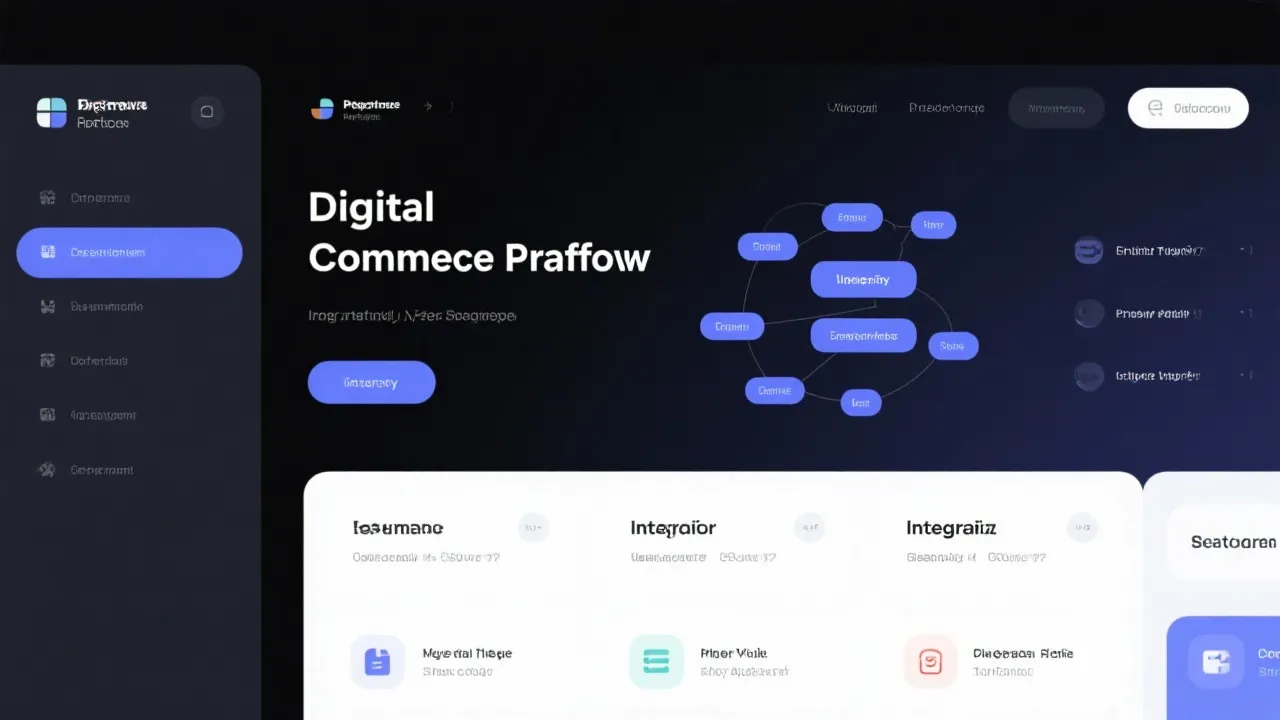Comparing Vtex and Salesforce Platforms
This guide delves into a comprehensive comparison between Vtex and Salesforce, two leading e-commerce platforms. Vtex, renowned for its multichannel capabilities, aligns with the modern demands of online retail, while Salesforce offers robust CRM solutions. Both platforms cater to different business needs, offering a plethora of features that maximize operational efficiency.

Understanding Vtex and Salesforce
E-commerce has become the cornerstone of retail, transforming how businesses interact with customers. Two industry titans, Vtex and Salesforce, offer cutting-edge platforms that enable businesses to thrive in this digital landscape. Vtex is celebrated for its multichannel capabilities and operational flexibility. In contrast, Salesforce provides an extensive Customer Relationship Management (CRM) system with robust analytical features. Understanding these platforms' unique offerings can empower businesses to optimize their e-commerce operations effectively.
Exploring Vtex: Features and Capabilities
Vtex stands out with its ability to support businesses in creating multichannel experiences, crucial in today's market where customers expect seamless interactions across various platforms. It facilitates a unified e-commerce approach, integrating online, offline, and third-party channels. Furthermore, Vtex's serverless architecture provides enhanced scalability, ensuring businesses can handle varying demands without performance issues. Developed with a focus on speed and flexibility, Vtex offers tools that enhance the shopping experience, from personalized recommendations to dynamic content management.
Another significant feature of Vtex is its modular architecture, which allows businesses to pick and choose functionalities according to their unique needs. This is particularly valuable for businesses that may not require a full suite of features right away but want the flexibility to scale and grow their capabilities over time. The development and customization capabilities allow e-commerce businesses to tailor their storefronts specifically to their target markets, enhancing user experience, while also streamlining operations such as inventory management and order fulfillment.
Moreover, Vtex provides an integrated marketplace model. Retailers can easily manage and integrate third-party marketplaces into their existing sales channels, allowing them to expand their reach rapidly while still keeping oversight of their entire operation. Additionally, Vtex’s content management system enables businesses to provide rich product descriptions, customer reviews, and other engaging content that can sway purchasing decisions.
Real-time analytics is another powerful tool within the Vtex ecosystem, allowing businesses to monitor user behavior, sales performance, and inventory status as it happens. This data can be critical in identifying trends, informing marketing strategies, and making swift operational adjustments to meet consumer demands without delay. By leveraging such comprehensive analytics, businesses can ensure they are always a step ahead in an ever-competitive landscape.
Delving into Salesforce: Comprehensive CRM and E-commerce
Salesforce is synonymous with advanced CRM solutions. It pioneers in delivering personalized customer experiences driven by data analytics. For businesses looking to blend CRM with e-commerce, Salesforce provides a seamless integration that connects customer interactions with transaction data, empowering businesses to craft personalized campaigns and improve customer retention. With Salesforce's AI-driven insights, businesses can anticipate customer needs, streamline their operations, and maintain a competitive edge.
Beyond basic CRM functionalities, Salesforce offers extensive features like Sales Cloud, Service Cloud, Marketing Cloud, and Commerce Cloud. Each of these offerings is designed to cater to various aspects of customer engagement, from lead management and sales forecasting to customer service and targeted marketing strategies. For example, Marketing Cloud provides tools for email marketing, social media integration, and customer journey mapping, allowing businesses to create accounts tailored specifically to individual customer experiences.
Another cornerstone of Salesforce is its capability for automation. Businesses can automate repetitive tasks, enabling sales teams to focus on more strategic activities rather than administrative tasks. This feature not only increases efficiency but also enhances team morale as employees spend more time engaging with customers and refining strategies rather than bogged down in manual processes.
Salesforce's integration capabilities are among the most robust on the market. It seamlessly connects with various applications and platforms, ensuring data consistency across different functions. Businesses can integrate it with various payment gateways, ERP systems, and marketing tools, consolidating their operations within one cohesive framework. This ensures a smooth flow of information and a unified approach to customer interactions, making it easier for businesses to follow up on leads and maintain customer relationships.
Comparing Vtex and Salesforce: A Detailed Analysis
When selecting an e-commerce platform, understanding the nuances of each option is imperative. Below is a comparison of Vtex and Salesforce based on several critical parameters:
| Feature | Vtex | Salesforce |
|---|---|---|
| Primary Focus | Multichannel E-commerce | CRM and E-commerce Integration |
| Architecture | Serverless, Scalable | Cloud-based, Intelligent CRM |
| Customer Insights | Personalized Recommendations | AI-driven Analytics |
| Integration | Seamless Multi-platform | Strong CRM to Sales Integration |
| Target Audience | Retailers, Multichannel Markets | Businesses focused on CRM Enhancement |
Additionally, businesses should consider the costs involved in each platform—while Vtex often provides a more straightforward pricing structure mainly revolving around transaction fees, Salesforce usually involves tiered pricing based on the number of users and the specific features required. This could mean that while Vtex may seem economically viable for smaller operations, Salesforce presents a better long-term investment for companies aiming to leverage comprehensive CRM capabilities to drive growth.
Industry Insights: Expert Perspectives
According to industry experts, choosing between Vtex and Salesforce depends largely on a company's primary operational goals. Businesses focused on expanding their omnichannel presence and needing an agile, scalable solution generally gravitate towards Vtex. Conversely, organizations seeking to leverage rich CRM data to enhance customer relationships and drive personalized marketing efforts might find Salesforce more fitting.
Experts in digital marketing emphasize the importance of integrating e-commerce with strong CRM capabilities to create a singular view of customer interactions. They point out that with Vtex's focus on multichannel e-commerce, businesses can reach customers on various platforms effectively, while Salesforce's extensive CRM features ensure that those interactions are rich and insightful. This duality means that businesses should consider hybrid strategies when evaluating their technology stacks.
Furthermore, as consumer behavior increasingly shifts toward mobile and socially-driven shopping experiences, both Vtex and Salesforce are adapting their platforms to incorporate these trends. Vtex has fought hard to maintain a marketplace approach that allows businesses to cater to on-the-go consumers, while Salesforce has expanded its capabilities to allow for customer-centric retail experiences from personalized app interfaces to tailored customer service solutions.
Future Trends in E-commerce Platforms
The landscape of e-commerce is rapidly evolving, with platforms continually enhancing their capabilities to meet new consumer expectations. As artificial intelligence and machine learning technologies become more advanced, platforms like Vtex and Salesforce are likely to expand their AI functionalities, offering even greater efficiencies and customer insights. The incorporation of AI services into both platforms has shown promising potential for enhancing user experiences, from chatbots providing instant customer support to personalized shopping recommendations generated through predictive analytics.
Furthermore, the emphasis on personalization will likely grow, compelling platforms to develop more sophisticated tools for creating tailored shopping experiences. This trend is driven by the recognition that modern consumers expect personalized interactions. Enhanced algorithms can analyze user behavior to predict future purchases and deliver recommendations that resonate on an individual level. As a result, we can anticipate that e-commerce platforms will harness data even more aggressively to allow businesses to forge deeper connections with their customers.
Another aspect many e-commerce solutions will begin incorporating more rigorously is social commerce—integrating social media functionalities into the shopping experience to take advantage of the growing trend of purchasing directly through platforms like Instagram, Facebook, and TikTok. E-commerce solutions that successfully merge effective social strategies with solid operational frameworks will likely outperform those that treat e-commerce and social media as separate entities.
Finally, sustainability is becoming an ever-more critical factor in consumer purchasing decisions. Only by prioritizing eco-friendly practices and sustainable supply chains can businesses hope to remain competitive. E-commerce platforms will need to adapt to this new reality by enabling businesses to exhibit their sustainability efforts effectively, whether through transparent supply chain practices, sustainability certificates, or showcasing products with eco-friendly features.
FAQs
- What are the primary differences between Vtex and Salesforce?
Vtex primarily focuses on multichannel capabilities, while Salesforce offers a robust CRM system with integrated e-commerce functions, excelling particularly in customer relationship management. - Can Vtex handle high transaction volumes?
Yes, Vtex's serverless architecture ensures scalability and can accommodate high transaction volumes efficiently, making it a sound choice for growing businesses. - Is Salesforce suitable for small businesses?
Salesforce provides solutions that cater to businesses of all sizes. While it’s particularly beneficial for larger organizations aiming to enhance customer management, small businesses can find tailored packages to suit their needs as well. - How does AI enhance these platforms?
AI enhances personalization and operational efficiency, providing valuable insights into consumer behavior and optimizing the shopping experience. Both platforms utilize AI for data analytics, helping businesses craft targeted marketing campaigns and improving customer support.
In conclusion, both Vtex and Salesforce bring distinct strengths to the table, catering to different business needs. By analyzing your company's objectives against the features offered by these platforms, you can choose a solution that aligns with your operational goals and customer engagement strategies. The key to success lies in leveraging the unique capabilities of each platform effectively and staying adaptable to the ever-changing dynamics of the e-commerce landscape. Tailoring your approach not only prepares your business for immediate challenges but also sets a solid foundation for future growth and sustainability in an increasingly competitive environment.
The decision to invest in either Vtex or Salesforce should also consider long-term strategies such as potential integration with other technologies, changes in consumer behavior, and evolving market trends. Strategic foresight will empower organizations to maximize their platform investments while building a robust framework that fosters customer loyalty and engagement.
Ultimately, your e-commerce success will depend heavily on how well you harness the tools provided by platforms like Vtex and Salesforce to create meaningful, lasting connections with your customers, streamline your operations, and navigate the complexities of the modern retail environment.
-

A Guide to Cost-Efficient Small Electric Cars for Seniors
-

Mastering Debt Consolidation: Boost Your Credit Score and Manage Interest Rates
-

Your Guide to Loans, Credit Checks, and Interest Rates
-

Affordable Independent Living: Finding the Right Senior Housing
-

Guide to Senior Living Apartments: Affordable and Comfortable Environments










